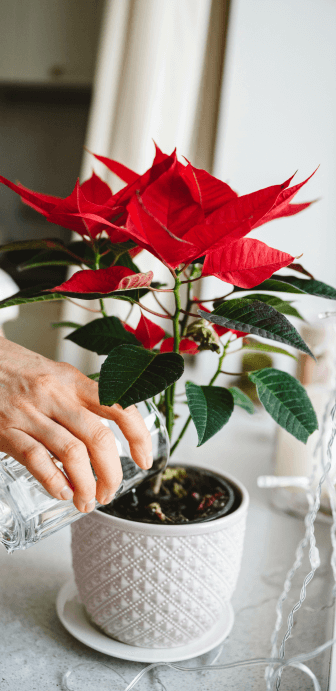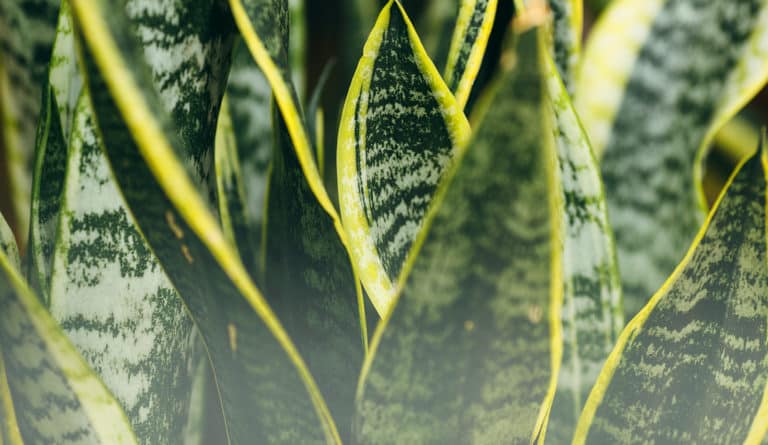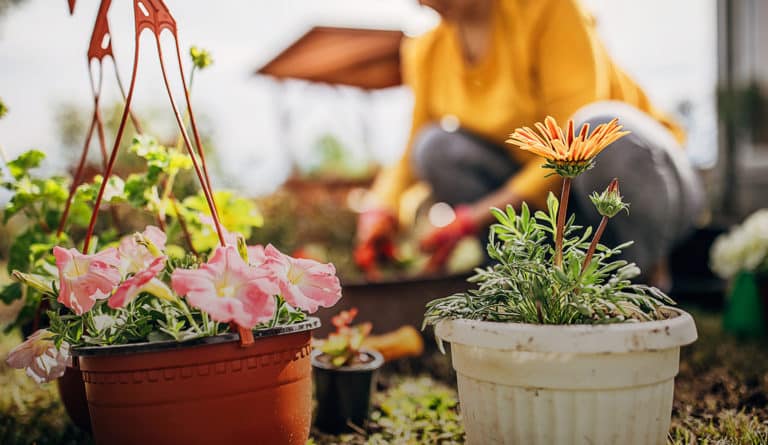
poinsettia
aka euphorbia pulcherrima
Poinsettia are native to Mexico and Central America. They are often used as decoration and gifts during Christmas holidays.
variations
There are over 100 varieties of Poinsettias. Some variations include ‘Premium Picasso’, ‘Monet Twilight’, ‘Shimmer’, and ‘Surprise’ poinsettia.
light
indirect
Need about 6 hours of indirect sunlight daily
water + feeding
not too thirsty
Water in moderation when soil is dry to the touch
toxic
kind of
They’re not toxic to humans or pets. However, the white, milky sap can irritate some people’s skin and can cause an upset stomach.
location
flexible
They’ll be happy in a semi-shaded or sunny area
humidity
love it
Poinsettia enjoy 50 – 75% humidity, so boost up the moisture
size
small friends
Potted poinsettia will remain small at 8 – 12 inches
pro tip
dry soil is ok
Allow the soil to dry out between watering, especially in the spring.
fun fact
need light and dark
The short days and long nights of fall and winter are perfect for poinsettia. It’s actually what causes them to bloom.


beyond the basics
-
soil + potting
Whether poinsettia is growing indoors or outdoors, they prefer a loose, well-draining potting mix. Consider using Miracle-Gro® Moisture Control® Potting Mix. You can also add Perlite and Peat Moss to your soil for some added nutrients.
-
when to repot
As your poinsettia grows, so does its roots. To avoid your poinsettia getting root-bound, repot it in the spring. It’s generally recommended that by mid-May, your poinsettia will be ready to repot. Choose a pot that is about 2 inches wider and deeper than its current pot. And of course, refresh the soil when you repot.
-
propagation
The most common way to propagate poinsettia is by taking a cutting. Propagating from cuttings ensures a clone of the parent plant. No surprises! To start, wait until the spring to take your cutting. Using sharp scissors or pruners, cut a 3 – 4 inch stem from the parent plant. Then cut off a few of the lower leaves to promote root growth from the cut edge. Be sure to leave at least 3 leaves at the top of the cutting. Transplant your cutting to a small container with well-draining potting mix such as using Miracle-Gro® Seed Starting Potting Mix. Keep your cutting in a bright, humid area, and mist the leaves regularly to stimulate growth.
-
pest control
Whiteflies are the most common pests for poinsettias. Do regular checks under the leaves of your poinsettia and keep an eye out for clumps of greenish eggs. Use a gentle insecticide like Ortho® Bug B Gon® ECO Insecticide Ready-to-Use to easily and quickly get rid of white flies.

troubleshooting
-
Why are my cuttings collapsing?
Bacterial rot. This causes the base or stem of the cuttings to become mushy and eventually collapse. You may also notice a smell surrounding your plant, which is also caused by this bacterial infection. You may be able to mitigate this by proper watering and misting practices. It’s best to cut off misting and watering for a while once you notice the stems are a little soft.
-
Why are my poinsettia’s leaves turning black?
Temperature fluctuations. Sudden temperature fluctuations will shock these tropical plants. To keep your poinsettia happy, make sure it’s in a bright space that can also receive a few hours of shade or darkness. Be sure to keep your plant away from radiators, fireplaces and space heaters too.
-
Why is my poinsettia so pale all of a sudden?
Could be spider mites. These little pests feed off the plant’s sap, causing the leaves to turn pale and sometimes develop little red spots. If you catch spider mites early enough, you may be able to salvage your plant. Use a gentle insecticide like Ortho® Bug B Gon® ECO Insecticide Ready-to-Use to gently take care of this problem. A recovering poinsettia will perk up and brighten up within a week or two.
-
Why are my poinsettia leaves drooping and yellow?
Over- or underwatering. Both over and under-watering your poinsettia will cause its leaves to droop or look wilted. If you’re over-watering your plant, be sure to let its soil dry out a bit. Discard any excess water at the bottom of its pot to prevent it from sitting water and developing root rot. If you’re underwatering, consider boosting your watering routine with Miracle-Gro Indoor Plant Food for the next two watering cycles. You can also start misting the leaves of your poinsettia to increase its water in-take. But don’t overdo it, let the soil dry out a bit between watering.
related articles
u003ca href=u0022https://www.plantprojectcanada.com/plant-chat/u0022u003ebecome a contributor. u003c/au003e



